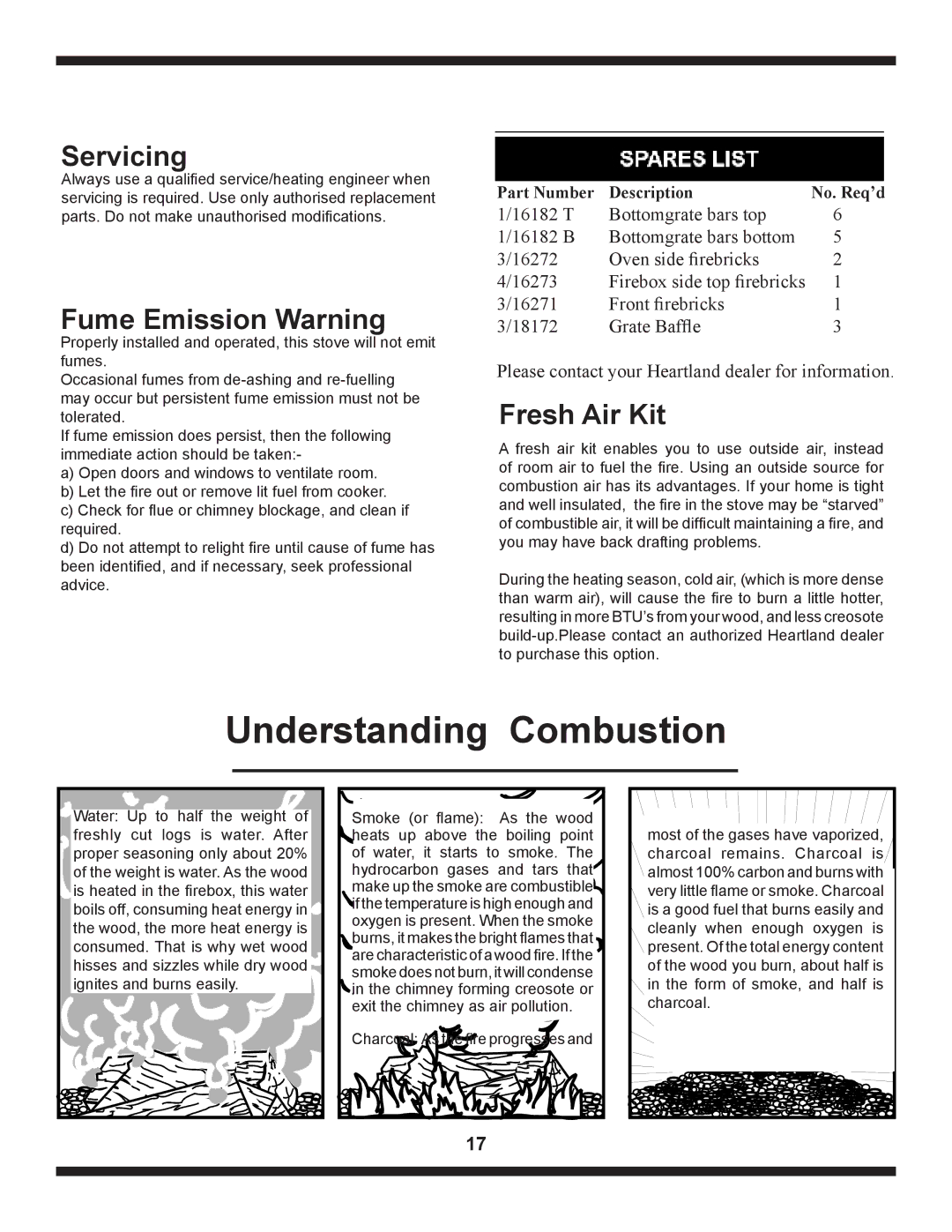
Servicing
Always use a qualified service/heating engineer when servicing is required. Use only authorised replacement parts. Do not make unauthorised modifications.
Fume Emission Warning
Properly installed and operated, this stove will not emit fumes.
Occasional fumes from
If fume emission does persist, then the following immediate action should be taken:-
a)Open doors and windows to ventilate room.
b)Let the fire out or remove lit fuel from cooker.
c)Check for flue or chimney blockage, and clean if required.
d)Do not attempt to relight fire until cause of fume has been identified, and if necessary, seek professional advice.
Part Number | Description | No. Req’d |
1/16182 T | Bottomgrate bars top | 6 |
1/16182 B | Bottomgrate bars bottom | 5 |
3/16272 | Oven side firebricks | 2 |
4/16273 | Firebox side top firebricks | 1 |
3/16271 | Front firebricks | 1 |
3/18172 | Grate Baffle | 3 |
Please contact your Heartland dealer for information.
Fresh Air Kit
A fresh air kit enables you to use outside air, instead of room air to fuel the fire. Using an outside source for combustion air has its advantages. If your home is tight and well insulated, the fire in the stove may be “starved” of combustible air, it will be difficult maintaining a fire, and you may have back drafting problems.
During the heating season, cold air, (which is more dense than warm air), will cause the fire to burn a little hotter, resulting in more BTU’s from your wood, and less creosote
Understanding Combustion
![]() Water: Up to half the weight of
Water: Up to half the weight of
freshly cut logs is water. After
![]() proper seasoning only about 20% of the weight is water. As the wood
proper seasoning only about 20% of the weight is water. As the wood ![]() is heated in the firebox, this water boils off, consuming heat energy in
is heated in the firebox, this water boils off, consuming heat energy in ![]() the wood, the more heat energy is consumed. That is why wet wood hisses and sizzles while dry wood
the wood, the more heat energy is consumed. That is why wet wood hisses and sizzles while dry wood![]()
ignites and burns easily.
Smoke (or flame): As the wood ![]()
![]() heats up above the boiling point of water, it starts to smoke. The hydrocarbon gases and tars that make up the smoke are combustible
heats up above the boiling point of water, it starts to smoke. The hydrocarbon gases and tars that make up the smoke are combustible![]() if the temperature is high enough and oxygen is present. When the smoke
if the temperature is high enough and oxygen is present. When the smoke
![]() burns, it makes the bright flames that
burns, it makes the bright flames that ![]() are characteristic of a wood fire. If the
are characteristic of a wood fire. If the ![]() smoke does not burn, it will condense
smoke does not burn, it will condense
![]() in the chimney forming creosote or
in the chimney forming creosote or
exit the chimney as air pollution.
Charcoal: As![]() the fire progresses and
the fire progresses and
most of the gases have vaporized, charcoal remains. Charcoal is almost 100% carbon and burns with very little flame or smoke. Charcoal is a good fuel that burns easily and cleanly when enough oxygen is present. Of the total energy content of the wood you burn, about half is in the form of smoke, and half is charcoal.
17
